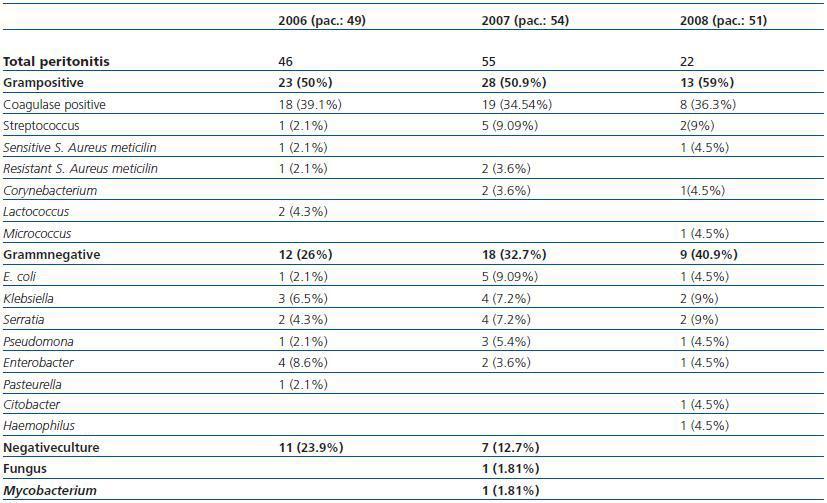Dear Editor,
Different recommendations have been published regarding the empirical treatment of peritonitis in peritoneal dialysis.1 In our centre we follow the recommendations of the Spanish Society of Nephrology published in 2004, which advise vancomycin, tobramycin and intraperitoneal ampicillin as initial treatment.2
In recent years it has been shown that oral ciprofloxacin is just as effective as an intraperitoneal antibiotic in the treatment of peritonitis.3
We carried out a retrospective study of all cases of peritonitis that occurred in our Unit from January 2006 until June 2008. There were 123 episodes in total. The germs responsible are outlined in table 1.
The sensitivity of gram-negative germs to ampicillin was evaluated based on the progressive increase of their resistance. In 2006, 58.3% were resistant and in 25% of the cultures, sensitivity to ampicillin was not evaluated. In 2007, 66.6% were resistant and sensitivity was not evaluated in 22% of cases. In 2008, the percentage of resistance reached 77.7% and it was not evaluated in 11.1%.
Sensitivity of gram-negative peritonitis to ciprofloxacin was 91% in 2006, 77.7% in 2007 (22.3% not tested) and 100% in 2008.
In terms of gram-negative peritonitis, in our centre there is a high percentage of cases of oxacillin-resistant germs and therefore treatment with vancomycin is required in the majority of occasions.
In light of the results, the empirical antibiotic protocol was changed to intraperitoneal vancomycin and oral ciprofloxacin, while maintaining antifungal prophylaxis with oral fluconazole, therefore avoiding treatment with aminoglycosides and their detrimental effect on residual renal function.
Peritoneal dialysis units must take into account the profile of the organisms responsible for peritonitis in their area, as well as the resistance pattern, when reciding the most suitable empirical antibiotic protocol in each case.
Table 1.







